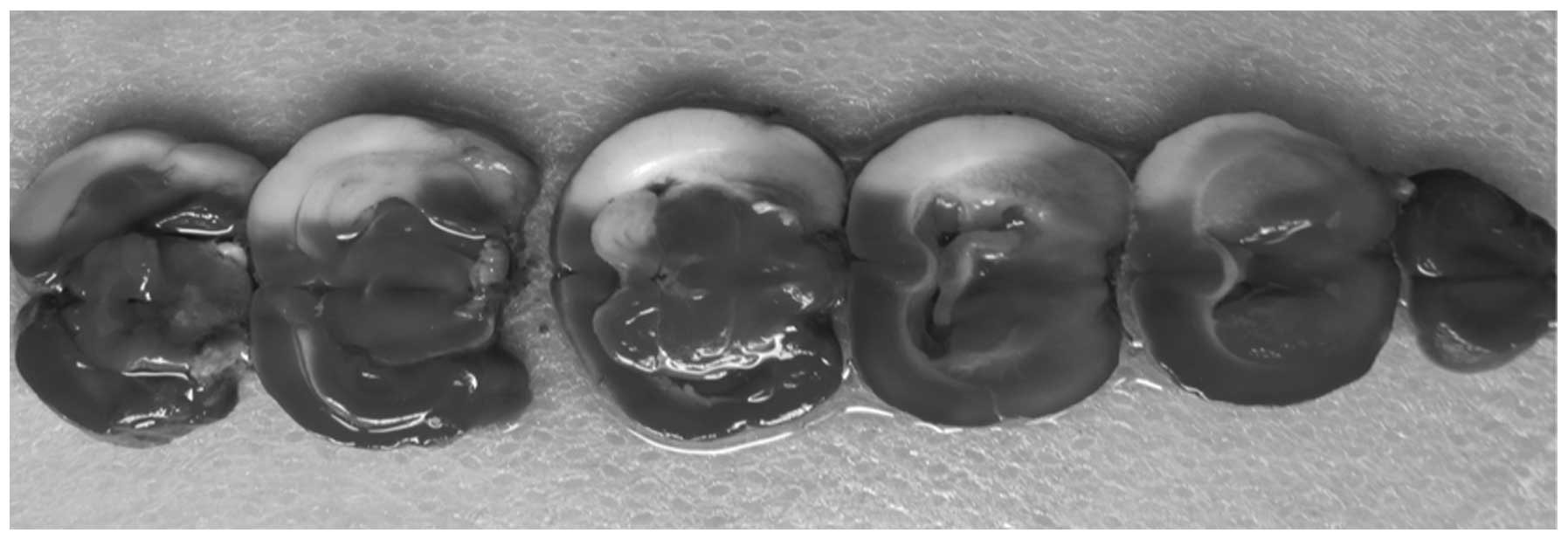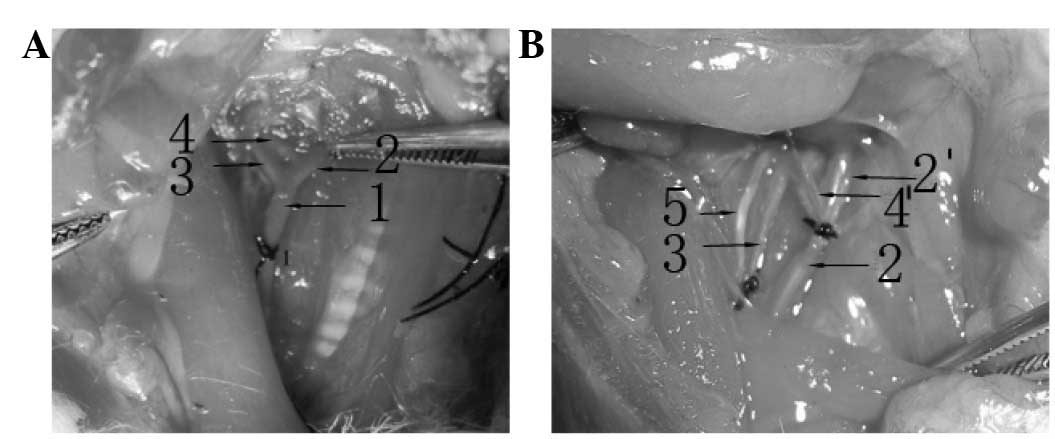|
1.
|
Rubiera M, Ribo M, Delgado-Mederos R, et
al: Tandem internal carotid artery/middle cerebral artery
occlusion: an independent predictor of poor outcome after systemic
thrombolysis. Stroke. 37:2301–2305. 2006. View Article : Google Scholar : PubMed/NCBI
|
|
2.
|
Hossmann KA: Cerebral ischemia: models,
methods and outcomes. Neuropharmacology. 55:257–270. 2008.
View Article : Google Scholar : PubMed/NCBI
|
|
3.
|
Li Y, Chen J, Chen XG, et al: Human marrow
stromal cell therapy for stroke in rat: neurotrophins and
functional recovery. Neurology. 59:514–523. 2002. View Article : Google Scholar : PubMed/NCBI
|
|
4.
|
Lubjuhn J, Gastens A, von Wilpert G, et
al: Functional testing in a mouse stroke model induced by occlusion
of the distal middle cerebral artery. J Neurosci Methods.
184:95–103. 2009. View Article : Google Scholar : PubMed/NCBI
|
|
5.
|
Koizumi J, Yoshida Y, Nakazawa T and
Ooneda G: Experimental studies of ischemic brain edema, I: a new
experimental model of cerebral embolism in rats in which
recirculation can be introduced in the ischemic area. Jpn J Stroke.
8:1–8. 1986.
|
|
6.
|
Wang Y, Tong ET and Xiao XH: Evaluation of
the modified model of reversible focal cerebral ischemia in rats by
MRI. Stroke Nervous Dis. 3:171–173. 1999.
|
|
7.
|
Chiang T, Messing RO and Chou WH: Mouse
model of middle cerebral artery occlusion. J Vis Exp. 27612011.
|
|
8.
|
Ma J, Zhao L and Nowak TS Jr: Selective,
reversible occlusion of the middle cerebral artery in rats by an
intraluminal approach. Optimized filament design and methodology. J
Neurosci Methods. 156:76–83. 2006. View Article : Google Scholar : PubMed/NCBI
|
|
9.
|
Longa EZ, Weinstein PR, Carlson S and
Cummins R: Reversible middle cerebral artery occlusion without
craniectomy in rats. Stroke. 20:84–91. 1989. View Article : Google Scholar : PubMed/NCBI
|
|
10.
|
Holland JP, Sydserff SG, Taylor WA and
Bell BA: Rat models of middle cerebral artery ischemia. Stroke.
24:1423–1424. 1993.PubMed/NCBI
|
|
11.
|
Engel O, Kolodziej S, Dirnagl U and Prinz
V: Modeling stroke in mice - middle cerebral artery occlusion with
the filament model. J Vis Exp. 24232011.PubMed/NCBI
|
|
12.
|
Taniguchi H and Andreasson K: The
hypoxic-ischemic encephalopathy model of perinatal ischemia. J Vis
Exp. 9552008.PubMed/NCBI
|
|
13.
|
Uluç K, Miranpuri A, Kujoth GC, Aktüre E
and Başkaya MK: Focal cerebral ischemia model by endovascular
suture occlusion of the middle cerebral artery in the rat. J Vis
Exp. 19782011.
|
|
14.
|
Ansari S, Azari H, McConnell DJ, Afzal A
and Mocco J: Intraluminal middle cerebral artery occlusion (MCAO)
model for ischemic stroke with laser doppler flowmetry guidance in
mice. J Vis Exp. 28792011.PubMed/NCBI
|
|
15.
|
Li Y, Chopp M, Chen J, Wang L, Gautam SC,
Xu YX and Zhang Z: Intrastriatal transplantation of bone marrow
nonhematopoietic cells improves functional recovery after stroke in
adult mice. J Cereb Blood Flow Metab. 20:1311–1319. 2000.
View Article : Google Scholar : PubMed/NCBI
|
|
16.
|
Chen J, Li Y, Wang L, Lu M and Chopp M:
Caspase inhibition by Z-VAD increases the survival of grafted bone
marrow cells and improves functional outcome after MCAo in rats. J
Neurol Sci. 199:17–24. 2002. View Article : Google Scholar : PubMed/NCBI
|
|
17.
|
Harper AJ: Production of transgenic and
mutant mouse models. Methods Mol Med. 104:185–202. 2005.PubMed/NCBI
|
|
18.
|
Koh PO: Melatonin attenuates decrease of
protein phosphatase 2A subunit B in ischemic brain injury. J Pineal
Res. 52:57–61. 2012. View Article : Google Scholar : PubMed/NCBI
|
|
19.
|
Carmichael ST: Rodent models of focal
stroke: size, mechanism, and purpose. NeuroRx. 2:396–409. 2005.
View Article : Google Scholar : PubMed/NCBI
|
|
20.
|
Florian B, Vintilescu R, Balseanu AT, et
al: Long-term hypothermia reduces infarct volume in aged rats after
focal ischemia. Neurosci Lett. 438:180–185. 2008.PubMed/NCBI
|
|
21.
|
Barber PA, Hoyte L, Colbourne F and Buchan
AM: Temperature-regulated model of focal ischemia in the mouse: a
study with histopathological and behavioral outcomes. Stroke.
35:1720–1725. 2004. View Article : Google Scholar : PubMed/NCBI
|
|
22.
|
Kapinya KJ, Prass K and Dirnagl U:
Isoflurane induced prolonged protection against cerebral ischemia
in mice: a redox sensitive mechanism? Neuroreport. 13:1431–1435.
2002. View Article : Google Scholar : PubMed/NCBI
|
|
23.
|
Sakai H, Sheng H, Yates RB, Ishida K,
Pearlstein RD and Warner DS: Isoflurane provides long-term
protection against focal cerebral ischemia in the rat.
Anesthesiology. 106:92–99. 2007. View Article : Google Scholar : PubMed/NCBI
|
|
24.
|
Browning JL, Heizer ML, Widmayer MA and
Baskin DS: Effects of halothane, alpha-chloralose, and
pCO2 on injury volume and CSF beta-endorphin levels in
focal cerebral ischemia. Mol Chem Neuropathol. 31:29–42.
1997.PubMed/NCBI
|
|
25.
|
Bouley J, Fisher M and Henninger N:
Comparison between coated vs. uncoated suture middle cerebral
artery occlusion in the rat as assessed by perfusion/diffusion
weighted imaging. Neurosci Lett. 412:185–190. 2007. View Article : Google Scholar : PubMed/NCBI
|
|
26.
|
Roos MW, Sperber GO, Johansson A and Bill
A: An experimental model of cerebral microischemia in rabbits. Exp
Neurol. 137:73–80. 1996. View Article : Google Scholar : PubMed/NCBI
|
|
27.
|
Alonso de Leciñana M, Diez-Tejedor E,
Gutierrez M, Guerrero S, Carceller F and Roda JM: New goals in
ischemic stroke therapy: the experimental approach - harmonizing
science with practice. Cerebrovasc Dis. 2(Suppl 2): 159–168.
2005.PubMed/NCBI
|
|
28.
|
Kim DE, Kim JY, Nahrendorf M, et al:
Direct thrombus imaging as a means to control the variability of
mouse embolic infarct models: the role of optical molecular
imaging. Stroke. 42:3566–3573. 2011. View Article : Google Scholar : PubMed/NCBI
|
|
29.
|
Dittmar M, Spruss T, Schuierer G and Horn
M: External carotid artery territory ischemia impairs outcome in
the endovascular filament model of middle cerebral artery occlusion
in rats. Stroke. 34:2252–2257. 2003. View Article : Google Scholar
|
|
30.
|
Akamatsu Y, Shimizu H, Saito A, Fujimura M
and Tominaga T: Consistent focal cerebral ischemia without
posterior cerebral artery occlusion and its real-time monitoring in
an intraluminal suture model in mice. J Neurosurg. 116:657–664.
2012. View Article : Google Scholar : PubMed/NCBI
|


















